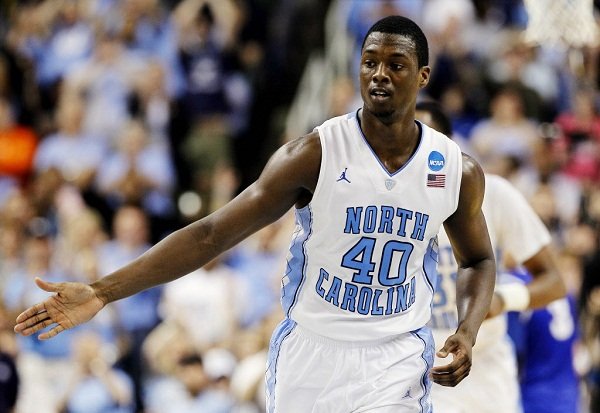Can Harrison Barnes Put His Elite Combine Scores To Use On the Court?
Posted by EJacoby on June 14th, 2012On Monday we analyzed this year’s NBA Draft Combine physical measurements, highlighting several players who posted notable numbers. Today we have a chance to dissect the athletic testing results, in which the Chicago Combine puts all competitors through a series of agility drills and strength assessments, enabling scouts to see which players display the greatest raw athletic ability. There’s probably more to gather from the testing portion as compared to the measurement sets, but the same rule applies that it’s difficult to draw any direct conclusions about how a player will translate his raw physical attributes into a live game setting. There’s no better example of that than Harrison Barnes, who developed a reputation during his two years at North Carolina as primarily a jump shooter, someone who doesn’t attack the basket as much as he prefers to face up on defenders and shoot pull-ups. But at the Combine, Barnes was the single most impressive athlete in camp. In the testing portion involving 52 competitors, he finished with the greatest vertical jump and fastest full sprint while cracking the top 10 of the bench press. Though Barnes was an effective scorer in college, his unwillingness to attack the basket was concerning. Barnes’ raw numbers at the Combine are suggestive that he should have greater success attacking in transition and getting to the rim than he did. But can he put his athleticism to use most effectively during the flow of the game at the next level? That’s the question NBA scouts are now asking themselves.
Barnes finished third in the ACC in scoring last season at 17.1 PPG on a team loaded with other offensive weapons, so it’s not like he failed to produce offensively as a Tar Heel. But digging deeper into his numbers, his overall efficiency output matched what the film showed, which is that he didn’t capitalize on his touches nearly as much as he could have. Barnes’ offensive rating (measuring a player’s point output per 100 possessions) of 108.1 did not even crack the top 20 in his conference, meaning that he didn’t produce points at a very high level given the amount of possessions that went his way. Given his great size (6’7″ without shoes), Barnes can shoot over defenders nearly any time he wants in the mid-range, but he decided to make that his go-to move in college. His true shooting percentage of 52.8% as a sophomore was very average for someone with his skill set and shooting ability. Also consider that his free throw rate (measuring FTA divided by FGA) of 37.4% didn’t crack the ACC’s top 20. If he can become more aggressive then there is clearly much room for growth in Barnes’ offensive game, the one thing that could propel him to make a leap to become a great NBA player.
As a comparison tool, let’s take a look at two other players battling Barnes as the top wing scorers in this draft. Michael Kidd-Gilchrist is known for his relentless work ethic and tremendous defense, but the freshman was actually a better offensive player than Barnes on an equally strong team. Kidd-Gilchrist averaged just 11.9 PPG but recorded a greater offensive rating (111.5) than Barnes last season. When he was featured with a possession, Kidd-Gilchrist was more effective at creating points, highlighted by a 57.0% true shooting percentage (much higher than Barnes). These numbers are boosted by MKG’s incredible 58.8% free throw rate, as he constantly attacked the rim with no fear of shot-blockers to earn the freebies. He even shot a better percentage at the line than Barnes. Meanwhile, Bradley Beal was just a freshman last year on another team with multiple weapons, yet he too was a far more efficient offensive player than Barnes. Beal’s true shooting percentage of 57.4% easily trumped Barnes, as he also got more shot attempts at the rim. His offensive rating of 112.2 was also better, and he got to the free throw line more frequently (44.0% free throw rate). His strength as a driver and three-point shooter helped Beal excel with his touches.
At the Draft Combine, Barnes outdid both players in terms of raw physical tools. He measured out taller (6’7″) than Kidd-Gilchrist (6’5.75″) and Beal (6’3.25″). He jumped higher than both players with a 38.0″ standing vertical leap compared to 32.0″ and 33.0″, respectively. He bench pressed more 185-pound reps (15) than either player (six and eight, respectively). And he ran faster in a 3/4 court sprint (3.16 seconds) than any player at the Combine, just barely surpassing MKG’s score of 3.18 seconds. The numbers clearly show that Barnes has more physical ability to beat defenders with his quickness or strength, and he has the athleticism to finish at the rim with anyone. Yet Kidd-Gilchrist and Beal were more efficient offensive weapons with a full year less of college experience. How do NBA general managers separate these players in terms of overall upside? With the right coach that will consistently push him to attack with greater confidence, there’s reason to believe that Harrison Barnes can become an offensive star at the next level.
Evan Jacoby is a regular contributor for RTC. You can find him on Twitter @evanjacoby.











































